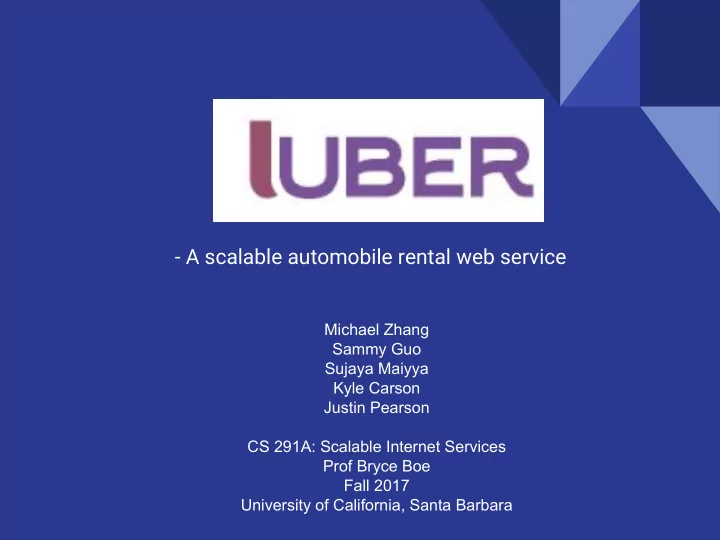

- A scalable automobile rental web service Michael Zhang Sammy Guo Sujaya Maiyya Kyle Carson Justin Pearson CS 291A: Scalable Internet Services Prof Bryce Boe Fall 2017 University of California, Santa Barbara
Outline ● App demo & details ● Tsung test setup ● Optimizations ○ Horiz. & vertical scaling ○ Pagination & Caching ○ Concurrent Nginx connections
Motivation - Sharing economy is efficient, environment-friendly and accessible to all. - A Uber or Lyft ride is not sufficient for all travelling demand, in case of family trip, long journey or private event. - We are proposing a Uber-Lyft-like long-term car-sharing app. - Cheaper option for less-populated area
Functionality - Car owners add their cars with make, model, color, year and tags. - Car owners set parameters to renting their car, ● start and end times ● start and end locations ● any additional terms they see fit - Car renters browse rentals with details, such as owner info, car info, time duration and geo-location on Google maps. - Car renters rent cars and monitor their progress.
Implementation - Framework : Ruby on Rails - Database : sqlite3 in dev and postgreSQL in production - Gems : bcrypt, will_paginate, geocoder, byebug - Server : AWS Elastic Beanstalk - Continuous Integration : Travis - Load testing : Tsung
https://safe-peak-44452.herokuapp.com/ App demo http://luber.fun -- coming soon
Data model Tags Rental sporty car seat sun roof Car User rents User owns actions written to Log
Outline ● App demo & details ● Tsung test setup ● Optimizations ○ Horiz. & vertical scaling ○ Pagination & Caching ○ Conncurrent Nginx connections
Tsung tests: Workflow of a “Typical User”
Tsung tests: Phases Exponentially increase “new users spawned per sec” Sessions don’t overlap
Tsung tests: Sessions Idempotent & each user acts in isolation => avoids concurrency problems
Tsung tests: Transaction Users selected from CSV file Posting redirects; capture the redirect URL from the HTTP header Follow the redirect, then get the id of the first editable car in the resulting HTML
Tsung tests: simultaneous users 16 u/s Tsung waits for all sessions 8 u/s to end before next phase 4 u/s # simult. users 2 u/s 1 u/s Test time (sec) 60 sec 60 sec 60 sec 60 sec Theory: 60-sec phase + trailing session takes 6-8 sec => humps should be max 70 sec wide This graph: 100 sec wide? => long server resp times / errors (4xx’s & 5xx’s) => this particular hw configuration cannot support 4usr/sec
Tsung tests: transaction time Good Bad Each tx has 1-sec think-time => 10-200ms “actual” waiting 2-8 sec for page load time taken for transaction (ms) Test time (sec) Test time (sec)
Outline ● App demo & details ● Tsung test setup ● Optimizations ○ Horiz. & vertical scaling ○ Pagination & Caching ○ Concurrent Nginx connections
Horiz. & Vertical Scaling
Cost analysis (max user rate s.t. no 4xx or 5xx http codes in tsung.log)
Pagination Reduced 4xx/5xx server responses & page response times. For 2 users/sec
Caching ● Russian-doll caching on views ● Only slight improvement; perhaps views not the bottleneck. ● Should’ve cached db queries also
Concurrent connections - AWS Elastic Beanstalk instances use Nginx web servers - Web servers can be one of the biggest bottlenecks for scaling an app
Concurrent connections
Concurrent connections: Solutions - Configure customized environment from project source by using .ebextensions - Created a various configuration files in the .ebextensions directory and ran redeployed eb instances - Manually logged into the instances, changed /etc/nginx/nginx.conf file No method worked! - Did some Network Tier optimization (connection draining, stickiness, health check..)
Is it a good idea to use third party services for your application?
Questions?
Recommend
More recommend